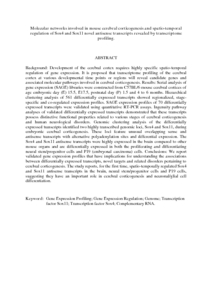Citation
Ling, King Hwa and Hewitt, Chelsee Ann and Beissbarth, Tim and Hyde, Lavinia and Banerjee, Kakoli and Cheah , Pike See and Cannon, Ping Z. and Hahn, Christopher N. and Thomas, Paul Q. and Smyth, Gordon K. and Tan, Seong-Seng and Thomas, Tim and Scott, Hamish S.
(2009)
Molecular networks involved in mouse cerebral corticogenesis and spatio-temporal regulation of Sox4 and Sox11 novel antisense transcripts revealed by transcriptome profiling.
Genome Biology, 10 (10).
104.
ISSN 1465-6906; ESSN:1465-6914
Abstract
Background:
Development of the cerebral cortex requires highly specific spatio-temporal regulation of gene expression. It is proposed that transcriptome profiling of the cerebral cortex at various developmental time points or regions will reveal candidate genes and associated molecular pathways involved in cerebral corticogenesis.
Results:
Serial analysis of gene expression (SAGE) libraries were constructed from C57BL/6 mouse cerebral cortices of age embryonic day (E) 15.5, E17.5, postnatal day (P) 1.5 and 4 to 6 months. Hierarchical clustering analysis of 561 differentially expressed transcripts showed regionalized, stage-specific and co-regulated expression profiles. SAGE expression profiles of 70 differentially expressed transcripts were validated using quantitative RT-PCR assays. Ingenuity pathway analyses of validated differentially expressed transcripts demonstrated that these transcripts possess distinctive functional properties related to various stages of cerebral corticogenesis and human neurological disorders. Genomic clustering analysis of the differentially expressed transcripts identified two highly transcribed genomic loci, Sox4 and Sox11, during embryonic cerebral corticogenesis. These loci feature unusual overlapping sense and antisense transcripts with alternative polyadenylation sites and differential expression. The Sox4 and Sox11 antisense transcripts were highly expressed in the brain compared to other mouse organs and are differentially expressed in both the proliferating and differentiating neural stem/progenitor cells and P19 (embryonal carcinoma) cells.
Conclusions:
We report validated gene expression profiles that have implications for understanding the associations between differentially expressed transcripts, novel targets and related disorders pertaining to cerebral corticogenesis. The study reports, for the first time, spatio-temporally regulated Sox4 and Sox11 antisense transcripts in the brain, neural stem/progenitor cells and P19 cells, suggesting they have an important role in cerebral corticogenesis and neuronal/glial cell differentiation.
Download File
![[img]](http://psasir.upm.edu.my/15711/1.hassmallThumbnailVersion/Molecular%20networks%20involved%20in%20mouse%20cerebral%20corticogenesis%20and%20spatio.pdf)  Preview |
|
PDF (Abstract)
Molecular networks involved in mouse cerebral corticogenesis and spatio.pdf
Download (85kB)
| Preview
|
|
Additional Metadata
Actions (login required)
 |
View Item |

